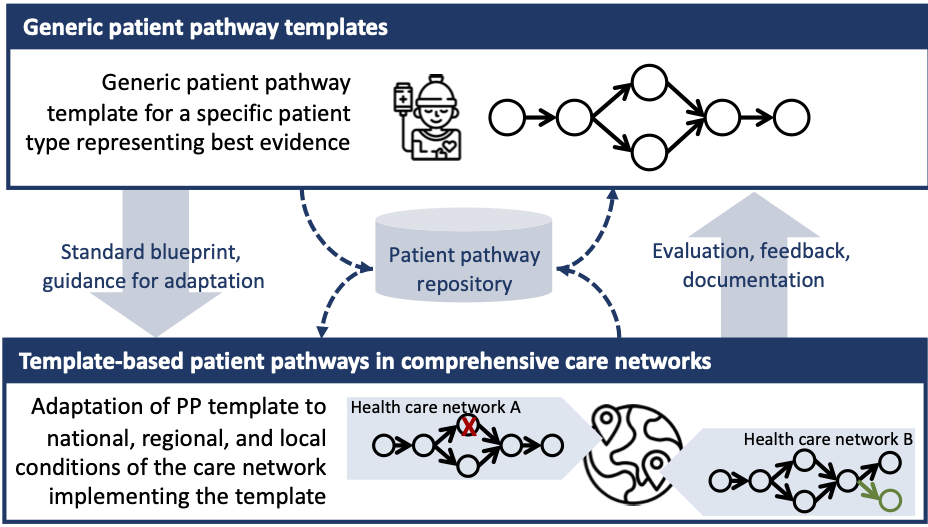02. 09. 2021
To coordinate cancer care on the national level and to increase access to quality cancer care, the implementation of Comprehensive Cancer Care Networks (CCCNs) is recommended by the European Guide on Quality Improvement in Comprehensive Cancer Control (CanCon Guide). One of the CCCNs’ tasks is the provision of practical support tools. In this context, comprehensive, integrated patient pathways are recognised as a valuable approach.
Whereas the term “patient pathway” is often used with regard to optimising cancer care processes and aligning information and communication flows, there are still central elements missing:
- a common terminological basis and understanding of the concept of patient pathways
- a methodical support for the development of patient pathways on national and network level.
In the light of these gaps, Task 10.2 (Patient Pathways) addresses the development of an agreed definition of patient pathways as well as of a method for creating and implementing patient pathways to be used in CCCNs and its units.
The following definition of patient pathways was developed and agreed upon in WP10:
“A patient pathway is an evidence-based tool that supports the planning and management of the care process of individual patients within a group of similar patients with complex, long-term conditions. It details the phases of care, guiding the whole journey a patient takes by defining goals and milestones, and supports mutual decision-making by the patient and his/her multidisciplinary care team collaborating in a comprehensive network of care providers.”
(Richter, Hickmann and Schlieter 2021)
Besides creating a uniform reference point with this definition, methodical support for CCCNs is provided with a patient pathway method. This method supports the development and implementation of patient pathways in CCCNs. It uses a patient pathway template approach that allows developing and implementing evidence-based tumour-specific patient pathway templates. Functioning as generic patterns, they can be adapted to the individual conditions and environments of specific CCCNs. This approach is expected to hold great potentials, e.g. a positive impact on creating a uniformly high level of quality care across European CCCNs, on reducing the difficulties and risks of patient pathway development for CCCNs and on improving the quality and comparability of patient pathways in CCCNs.
Figure 1. The template-based patient pathway approach (© Peggy Richter, Icons made by Freepik and srip from www.flaticon.com)
Two specific patient pathway templates for Comprehensive Cancer Care Networks were developed using this patient pathway development method – for pancreatic and colorectal cancer. They are currently being tested and implemented in the WP10 pilot sites in Poland (LSOC Wrocław) and Germany (Charité Berlin).
Documents
What are patient pathways? With a systematic scoping review, typical themes in the literature and key characteristics of patient pathways distinguishing them from other pathway approaches were identified.
Patient pathways in oncology care – what is the state of play? The results of a systematic literature review reflect on the state of the art of patient pathways in oncology care. Furthermore, a survey among WP10 members provides insights into the current practice, expectations, and understanding of patient pathways from a practical point of view.
- Patient pathways in oncology care
- Are you on the (path)way yet? A survey examining the understanding and implementation of oncological patient pathways among WP10 members
How should patient pathways for comprehensive care networks be developed? A method for the development of patient pathways was designed and tested with the development of patient pathway templates for pancreatic and colorectal cancer.
- iPAAC patient pathway guide (iPa2-Guide) – a guide for the development of generic patient pathway templates and their implementation in comprehensive cancer care networks
- Consolidated patient pathway framework for their development and implementation
- Patient pathway development method
- Template for tumour-specific patient pathways: example of colorectal cancer
- Template for tumour-specific patient pathways: example of pancreatic cancer
Contacts
- Peggy Richter (peggy.richter2@tu-dresden.de)
- Hannes Schlieter (hannes.schlieter@tu-dresden.de)
References
- Richter, P. Hickmann, E., Schlieter, H. (2021). Validating the concept of patient pathways: a European survey on their characteristics, definition and state of practice. Pacific Asia Conference on Information Systems 2021: 32.
